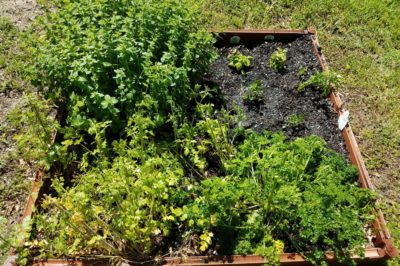What’s better: raised beds of wood or stone?
Simple, raised beds can be constructed from wooden planks which are connected at angles and fixed to their location by waterproofed, wooden piles. However, not every type of wood is suitable: unplaned larch planks have proven to be especially suitable for bedding as they are resinous and do not rot as quickly as other types of wood. Alternatively, you can use robinia (black locust) or oak wood. In any case, the thickness of the planks should be at least 3 centimeters. You may also make raised beds from stone, which will be more durable than any wood. These can be made of brick, lime sand or concrete blocks. Given the heavier weight, using stone would require a concrete foundation whereas wood would not.
Lining the inside of raised beds prior to filling
Before filling the raised bed with soil, you must protect it against moisture. Raised wooden beds can be waterproofed from the inside or lined with roofing felt. In the latter case, be careful not to use any degassing materials. Brick or sand-lime brick walls, on the other hand, must be painted with waterproof paint. Rodents can be kept away by installing a durable wire mesh on the bedding.
Filling a raised bed optimally
By far, the most important part of the process is choosing the right filling. A raised bed works best when built up like a well-layered compost heap. The lowest layer will consist of shredded material or chopped twigs, but you should not use acidic softwoods. This should be followed by a layer of leaves covered with ripe compost. Then topsoil (which should make up about 50% of the filling) and finally a thin layer of compost. The bed must be absolutely full, as the process of decomposition will quickly consume the bed. In autumn, fill the sacked soil with fresh compost.
Building a raised bed – step by step
Here we show you how you can build a simple raised bed yourself:
- Select a suitable location.
- Remove wild herbs from the soil.
- Level it with a rake.
- Set up the wooden planks.
- Level it again.
- Screw it on.
- Fill the raised bed.
- Now you can plant it in close rows.
- The pouring is especially important.
Hint
after three years (at the latest), the contents of the raised bed will have been completely composted and the structure must be renewed.












